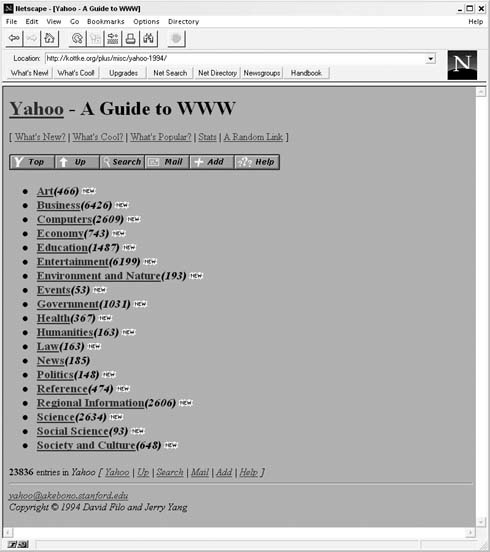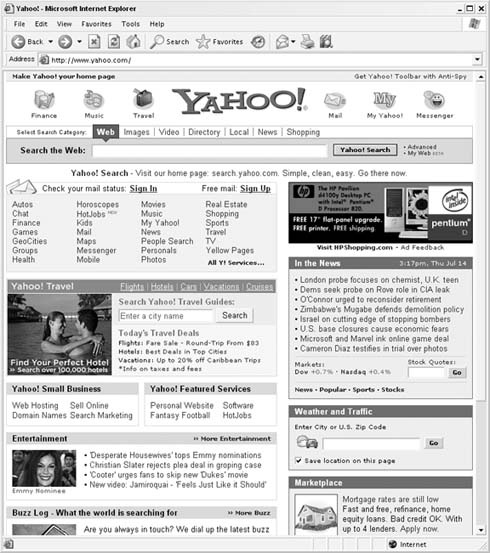Yahoo! is an impressive example of what can happen when a hobby takes on a life of its own. In 1994, Jerry Yang and David Filo began publishing a personal list of sites they found interesting on the emerging World Wide Web. As “Jerry’s Guide to the World Wide Web” grew larger, the two Stanford grad students began organizing the sites into categories, and the basic structure of today’s Yahoo! Directory was born. By late 1994, they chose to rename their directory after the word yahoo because its original definition describing a crude, rude person appealed to the pair’s subversive natures. (And as true computer geeks, they turned Yahoo! into an acronym for Yet Another Hierarchical Officious Oracle.) Figure P-1 is a look at the Yahoo! home page from December 1994.
Yahoo! looks very different today. Figure P-2 shows the more familiar Yahoo! home page of 2005.
Though the two Yahoo! home pages look radically different, the original idea of taming the chaos of the World Wide Web and making it accessible to a wider audience remains. According to their vision statement, Yahoo! wants “to enable people to find, use, share, and expand all human knowledge.” The goal of furthering this vision, nicknamed FUSE (for “find, use, share, and expand”), can be found in every acquisition Yahoo! makes and every product Yahoo! releases. Yahoo! has localized versions of its offerings in dozens of countries, and the Yahoo! brand is recognized around the world. Over the past 10 years, Yahoo! has become much more than a guide to the Web; Yahoo! is a platform for visualizing and connecting with the world.
Many Yahoo! features are familiar to anyone who uses the Web. Millions of people use Yahoo! Search to find information on the Web. Millions more use Yahoo! Groups to share information and collaborate on projects. And still more use Yahoo! Mail every day to stay in touch with friends, family, and coworkers. And Yahoo! is continually adding products and features to realize its vision.
Over the past year, the FUSE philosophy has been a distinct feature of Yahoo!’s newest services. In February 2005, Yahoo! launched Yahoo! Web Services, allowing outside developers to use, share, and expand Yahoo! features. In March 2005, Yahoo! launched Yahoo! 360, a way for people to share thoughts and information with friends and family, while expanding a network of friends. In April 2005, Yahoo! introduced My Web, a way to save and share search results while creating your own personal categorized directory of the Web.
This book aims to help you FUSE Yahoo! features and services by introducing you to little-known corners of Yahoo!, by reintroducing you to familiar Yahoo! services, and by showing you examples of the many ways people are expanding Yahoo! on their own. Though the hacks might be crude and rude at times, they’re written in the same spirit of sharing something interesting that inspired the creation of Yahoo! in the first place.
Get Yahoo! Hacks now with the O’Reilly learning platform.
O’Reilly members experience books, live events, courses curated by job role, and more from O’Reilly and nearly 200 top publishers.



